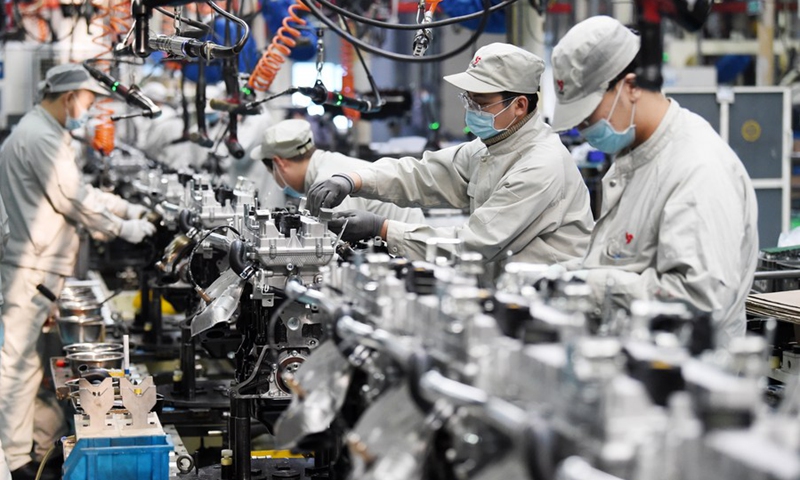Chinese local governments speed up implementation of policy to stabilize economy in crucial quarter

People work at a workshop of Harbin Dongan Automotive Engine Manufacturing Co., Ltd. in northeast China's Heilongjiang Province, Feb. 25, 2021.(Photo: Xinhua)
Senior leaders of several Chinese provinces have recently made field trips to coordinate on the solution to problems encountered by the local economy, the latest efforts by China’s local authorities to promote the implementation of various policies and measures aimed at stabilizing the economy.
The move, together with other local efforts aimed at stabilizing the economy, shows that the previous national video teleconference with more than 100,000 participants and other pro-growth meetings are having a huge effect across the country, which may facilitate a better-than-expected recovery in the local economy, experts noted.
Zheng Shanjie, Party secretary of East China’s Anhui Province, on Thursday listened to opinions and demands face-to-face from businesses in an on-site meeting in Hefei's Baohe district, in an aim to help enterprises address challenges, the Anhui Daily reported.
During an inspection trip in Ganzhou this week, Ye Jianchun, governor of East China’s Jiangxi Province, stressed going all out to achieve the economic targets for the second quarter on the premises of ensuring safety, high quality and environmental protection, laying a solid foundation for robust economic development for the whole year, according to the provincial government’s website.
The week also saw Feng Fei, governor of South China’s Hainan Province, go to Sanya to supervise local economic work and coordinate the solution of relevant problems so as to promote local economic development.
Moreover, a number of provinces including Central China’s Henan and Northwest China’s Gansu have also held meetings on the work deployment aimed at stabilizing and promoting economic growth.
All these mark the latest efforts at local levels when it comes to ensuring the implementation of a 33-item stabilization policy package released by the State Council at the end of May following an unprecedented national video teleconference with more than 100,000 participants, experts said. It is at the meeting that Premier Li Keqiang stressed the implementation and effect of all stabilizing measures to safeguard market entities, employment, people’s livelihood and keep the economy operating in a reasonable range.
After a series of recent pro-growth meetings at the central level, it’s now dependent on whether local efforts can keep the economy within a reasonable growth range in the second quarter. Whether the Chinese economy can shrug off the serious impacts of domestic epidemic flare-ups and complicated international environment in the second quarter is crucial to achieving the full-year growth target of 5.5 percent, Tian Yun, former vice director of the Beijing Economic Operation Association, told the Global Times on Saturday.
There is no denying that China’s economic development is facing headwinds due to the country’s worst epidemic outbreak in two years, but the government’s support measures are expected to help resolve challenges and boost confidence, Dong Dengxin, director of the Finance and Securities Institute of the Wuhan University of Science and Technology, told the Global Times.
While the temporary economic shock may be understandable given the unexpected epidemic situation in Shanghai, it also indicates an imperative to step in quickly and bring the economy back to track. “If the economy is stuck in a low-growth state for too long, the costs of bringing it back to original track will be huge,” Tian explained. This is also why all levels of governments -- from the State Council, the cabinet to ministries to local governments – are racing to boost economic growth.
Although the current economic operation has encountered some difficulties and downward pressure, experts are generally confident in a strong rebound in the Chinese economy in the third and fourth quarters, as China’s economic fundamentals haven’t changed.
Take the latest trade data as an example. In May, China's exports stood at $308.25 billion, up by 16.9 percent on a yearly basis, significantly rebounding from the 3.9 percent growth in April, data from the General Administration of Customs (GAC) showed on Thursday.
The growth figure, which far exceeded forecasts of around 8 percent, indicates that the Chinese industrial chain and supply chain, especially in the Yangtze River Delta region, is recovering in a faster-than-expected pace, an indication that the Chinese economy may be more resilient than many had forecast, Tian noted. This, together with the supportive measures aimed at boosting the economy, has and will continue to inject great confidence into the market and the real economy at the critical junction of the Chinese economy.


